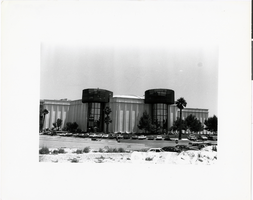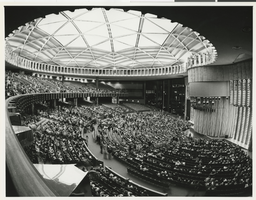Search the Special Collections and Archives Portal
Search Results

Photograph of a large group of people near the swimming pool at the Hotel Last Frontier, 1940s
Date
Archival Collection
Description
Crowded swimming pool area of the Hotel Last Frontier, yet nobody is in the pool. The sign for the Ramona Room is also visible.
Site Name: Frontier
Address: 3120 Las Vegas Boulevard South
Image

Photograph of the exterior of the Aladdin Theatre for the Performing Arts (Las Vegas), circa 1979
Date
Archival Collection
Description
Aladdin Theatre of the Performing Arts exterior.
Site Name: Aladdin Hotel
Address: 3667 Las Vegas Boulevard South, Las Vegas, NV
Image

Photograph of the front exterior of the Flamingo Hilton (Las Vegas), circa 1979
Date
Archival Collection
Description
Flamingo Hilton circa 1979
Site Name: Flamingo Hotel and Casino
Address: 3555 Las Vegas Boulevard South
Image

Photograph of the Aladdin and Dunes from Las Vegas Boulevard (Las Vegas), late 1960s
Date
Archival Collection
Description
Looking north down the Strip with the Aladdin on the right and the Dunes on the left.
Site Name: Las Vegas Strip
Address: Las Vegas Boulevard, Las Vegas, NV
Image

Photograph of Anita and Charles Perri at the Tropicana swimming pool (Las Vegas), April 1957
Date
Archival Collection
Description
Two children, Anita and Charles Perri, near the swimming pool of the Tropicana in April, 1957. Handwritten text from back of photo: "Tropicana Hotel, Apr. 1957. Anita and Charles Perri."
Site Name: Tropicana Hotel
Address: 3801 Las Vegas Boulevard South, Las Vegas, NV
Image

Photograph of artist's concept, Aladdin Theatre of Performing Arts (Las Vegas), circa 1971
Date
Archival Collection
Description
Artist's conception of the Aladdin Theatre of Performing Arts. Handwritten inscription on back of photo: "Theatre of Performing Arts."
Site Name: Aladdin Hotel
Address: 3667 Las Vegas Boulevard South, Las Vegas, NV
Image

Photograph of the Aladdin theatre for the performing arts exterior (Las Vegas), 1970s
Date
Archival Collection
Description
The Aladdin Theatre for the Performing Arts from the side. Handwritten inscription on back of photo: "Side view Theatre of Perf. Arts Aladdin"; LV News Bureau photo #34514."
Site Name: Aladdin Hotel
Address: 3667 Las Vegas Boulevard South, Las Vegas, NV
Image

Photograph of the Aladdin theatre for performing arts interior (Las Vegas), 1970s
Date
Archival Collection
Description
An interior view of the Aladdin Theatre for the Performing Arts. Handwritten inscription on back of photo: "Interior- Theatre of the Performing Arts, Aladdin."
Site Name: Aladdin Hotel
Address: 3667 Las Vegas Boulevard South, Las Vegas, NV
Image

Photograph of delicatessen in the Aladdin Theatre of the Performing Arts (Las Vegas), circa 1972
Date
Archival Collection
Description
Patrons dining in the delicatessen in the Aladdin Theatre of the Performing Arts. Handwritten inscription on back of photo: "Interior- Theatre of the Performing Arts, Aladdin."
Site Name: Aladdin Hotel
Address: 3667 Las Vegas Boulevard South, Las Vegas, NV
Image

Photograph of interior of the Aladdin Hotel convention area (Las Vegas), 1970s
Date
Archival Collection
Description
A conference room in the convention area of the Aladdin Hotel. Handwritten inscription on photo: "Convention Area Aladdin Hotel."
Site Name: Aladdin Hotel
Address: 3667 Las Vegas Boulevard South, Las Vegas, NV
Image
